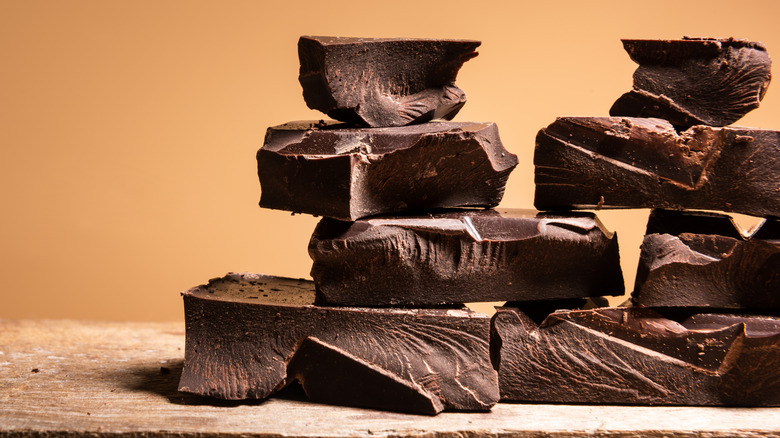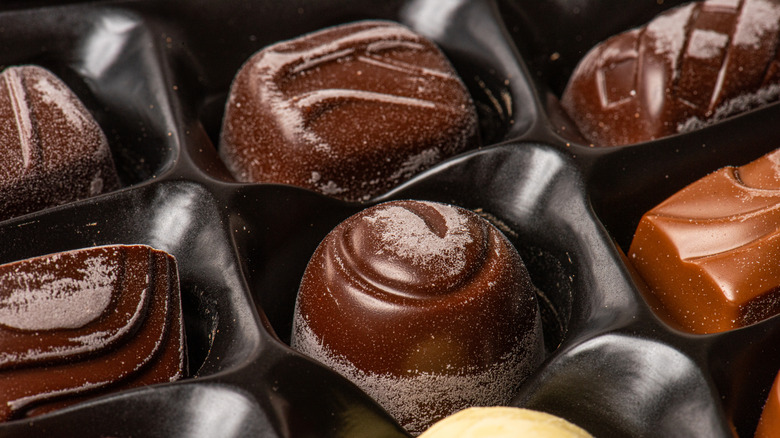The Simple Trick To See If Chocolate Is High Quality
The cacao tree is where chocolate comes from, and while the ancient Olmec civilization was using it in ceremonies 3,500 years ago, it wasn't until the 19th century that it became accessible to the masses. Today, it's a ubiquitous sweet treat, with quality ranging widely, from mass-produced Hershey's to higher-end La Maison du Chocolat. How can you tell if you have a more refined chocolate bar without looking it up? Marissa Stevens, recipe developer and founder of Pinch and Swirl, shared with Food Republic that there's a simple trick — just snap a piece off the bar and listen.
"A clean, crisp snap usually means the bar is well-tempered and the cocoa butter is set in a stable structure," she explained. According to Stevens, a bar of chocolate that doesn't give a satisfying snap might have been poorly tempered, or worse, could have fallen victim to chocolate bloom — that white coating on the surface of chocolate bars that is safe to eat but can soften the bar and impact the flavor.
"Be sure to do the test at cool room temp, about [68 to 72 degrees Fahrenheit], and compare like with like," she advised. Stevens noted that dark chocolate has the best snap, while milk and white chocolate — which many don't consider chocolate at all — as well as nut-studded varieties, won't have as crisp a sound when breaking, but that's fine.
Visual signs you've got high-quality chocolate
Hearing isn't the only sense you can use to determine if you have high-quality chocolate. As Marissa Stevens told Food Republic, you can also learn a lot by how the bar looks. "You want a smooth, even shine and clean edges," she said. Gray streaks can indicate fat bloom, which occurs when chocolate has been subjected to warmer temperatures, causing the cocoa butter to separate. On the other hand, she explained that "dusty, rough patches point to sugar bloom from moisture." Both conditions indicate that the chocolate wasn't well-tempered. They're safe to eat, but the texture won't be ideal.
Sight also comes into play when reading the ingredients list. A shorter list is better, Stevens advised. Cocoa mass or liquor (milk chocolate must contain at least 10% cocoa liquor), sugar, cocoa butter, lecithin, and real vanilla are good signs. Skip bars with lots of oils or artificial flavors. Also, a higher percentage of cacao doesn't necessarily mean the bar is better — Stevens noted it simply indicates more cocoa solids.
How good chocolate should smell, feel, and taste
There are three more senses you can use to evaluate the quality of the chocolate you're about to enjoy. First is smell. Marissa Stevens suggested breaking off a square and giving it a sniff. "Good chocolate smells like cocoa right away, with a note you can name — fruity, nutty, or toasty," she said. If you can't smell anything, you probably won't taste much, either.
Next is touch, both before and during eating. Stevens described a finger rub test: pick a corner and rub it between your index finger and thumb. If it gets shinier with friction, it's likely better quality, as it indicates proper tempering. Then, place a piece on your tongue. "Quality chocolate melts quickly and feels silky, not waxy or gritty," she said.
Finally, taste. Fine chocolate has a balanced flavor, with distinct notes but no single element overpowering the rest. It shouldn't be flat, one-dimensional, or artificial. After swallowing, a well-made chocolate's taste lingers. "If it disappears fast or turns chalky, it wasn't great," Stevens said.



